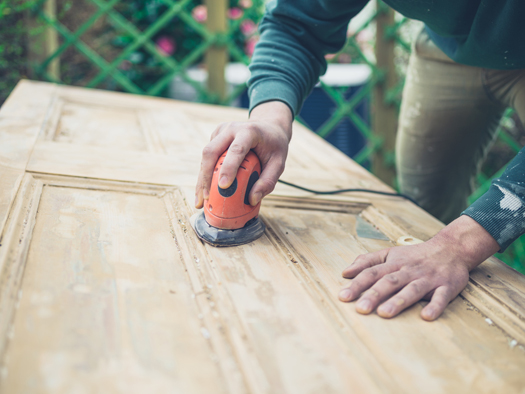Your Home Environment: What You Can’t See Can Harm You

Recently I received a call from a friend who wanted information about high lead levels in the blood. I’m a nurse. I’ve worked for the Aging and Disability Services for more than 22 years and I have lots of connections with health care providers, but I didn’t know the answer to his question because I had never been asked about lead before.
My friend’s child—a toddler—had high levels of lead in his blood. Their pediatrician reported it to the Public Health Department, but this concerned father wondered if there was anyone I could contact on his behalf.
I was able to navigate the Public Health website to find the right division. Soon after leaving a message, I received a call back from Sharon, an environmental health investigator. She verified receiving the pediatrician’s report and was in contact with the child’s mother and father. Sharon set up a home visit, which she conducted along with her colleague Matt.
My friend contacted me a while later to report that the cause of high lead levels in his child’s blood were toys—little animal figurines purchased by the family in India many years ago. His son favored these toys, and he chewed on them—as toddlers do. They were removed immediately.
It was a relief to this family to have professional guidance and support from the Public Health Department. We are thankful to Sharon and Matt for their timely inspection.
I decided I wanted more information to share with AgeWise King County readers. It may help you or someone you know and love. Their excellent customer service shows care and concern for King County residents.
What are common sources of lead?
Lead-based paint and lead-contaminated dust are the most common sources of lead poisoning. These can be found in:
- Older homes—those built before 1978 may have lead-based paint.
- Deteriorating lead-based paint around buildings and old playground equipment.
- Soil and sediment polluted by car exhaust or chipping house paint.
- Toys made and painted outside of the United States.
- Lead-glazed ceramic ware, pottery, stained glass, and leaded crystal.
- Imported candy and spices.
- Workplace and hobby hazards such as lead batteries, scrap metal recycling, gun parts, firing ranges, leaded fishing weights, ammunition, and furniture refinishing.
- Lead pipes, which can contaminate drinking water.
- Traditional home remedies and cosmetics such as Surma (a ceremonial dye) and kohl or kajal eyeliners.
Adults can be exposed to lead from their jobs and hobbies. Children are mostly exposed to lead through ingestion. It is normal behavior for young children to put fingers, toys, and other objects in their mouths.
What are potential signs/symptoms of lead poisoning in children?
The effects of lead exposure are usually hard to see. In most individuals, the harmful effects of lead are subclinical and generally too small to be easily noticed in a routine medical examination. If there are noticeable signs, they may include permanent damage to the brain and nervous system, leading to behavior and learning problems, lower IQ, hearing problems, slowed growth, irritability, loss of appetite, weight loss, sluggishness, fatigue, abdominal pain, delayed puberty and/or anemia.
How can lead poisoning be prevented?
Steps you can take to lower the chances of exposure to lead include:
- Keep your home clean and dust-free.
- Inspect and maintain all painted surfaces. When old paint cracks and peels, it makes dangerous dust.
- Clean painted areas where friction can generate dust, such as doors, windows, and drawers with a wet sponge or rag.
- Remodel, repair, and paint old homes safely. Sanding or scraping paint can create lead dust. Make sure your contractor is lead-safe certified by the Environmental Protection Agency (EPA).
- Wash children’s hands, bottles, pacifiers, and toys often.
- Eat well-balanced meals with calcium, iron, and vitamin C. Children with healthy diets absorb less lead.
- Remove shoes and wash hands after working or playing outdoors to avoid bringing in soil that may contain lead.
- If you’re exposed to lead at work, don’t bring it home. Use separate work clothes and shoes. Shower before coming home or as soon as you get home. Put dirty work clothes in a plastic bag and wash them separately from other clothes.
- If you have a hobby that exposes you to lead, don’t contaminate your home. Keep children and pregnant women out of the area.
- Look at toy and jewelry product recalls due to lead.
- Avoid using home remedies and cosmetics that contain lead.
- Avoid using imported pottery, dishware, and ceramics for food and drinks if unsure of its lead content.
Chemicals, molds, and other common airborne hazards
Childhood and adult asthma is common. Many people take asthma medications, including inhalers, but if the home environment isn’t clean and safe, symptoms may not be controlled. Mold allergy symptoms include wheezing, rash, watery eyes, runny nose, itchy eyes, coughing, and redness of the eyes.
How do you know if the air in your home is healthy? If you live in Seattle, the American Lung Association of Washington’s Master Home Environmentalist program can conduct a free healthy Home Check-up to let you know if you have mold, mildew, dust mites and/or ventilation problems. They’ll also help you resolve the problems. If you live outside of Seattle, you can conduct your own Do-it-Yourself Healthy Home Check-up. For more information, call the Lung Association at 206-512-3280 or e-mail mhe@lung.org.
Whether you are a parent, grandparent, loved one, friend, or consumer, living a safe and healthy life is important.
Contributor Mary Pat O’Leary, RN is a planner at Aging and Disability Services—the Area Agency on Aging for Seattle-King County. She thanks Sharon Cohen and Matt Wilson of Public Health—Seattle & King County for the assistance they provided. For more information about the ways that Public Health promotes safe and healthy environmental conditions throughout King County, click here.
![AgeWise King County [logo]](https://www.agewisekingcounty.org/wp-content/themes/agewisekingcounty/images/logo.png)